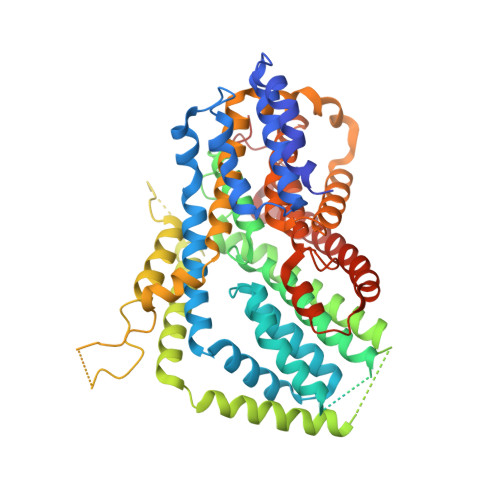Structure and inhibition mechanism of the human citrate transporter NaCT.
Sauer, D.B., Song, J., Wang, B., Hilton, J.K., Karpowich, N.K., Mindell, J.A., Rice, W.J., Wang, D.N.(2021) Nature 591: 157-161
- PubMed: 33597751
- DOI: https://doi.org/10.1038/s41586-021-03230-x
- Primary Citation of Related Structures:
7JSJ, 7JSK - PubMed Abstract:
Citrate is best known as an intermediate in the tricarboxylic acid cycle of the cell. In addition to this essential role in energy metabolism, the tricarboxylate anion also acts as both a precursor and a regulator of fatty acid synthesis 1-3 . Thus, the rate of fatty acid synthesis correlates directly with the cytosolic concentration of citrate 4,5 . Liver cells import citrate through the sodium-dependent citrate transporter NaCT (encoded by SLC13A5) and, as a consequence, this protein is a potential target for anti-obesity drugs. Here, to understand the structural basis of its inhibition mechanism, we determined cryo-electron microscopy structures of human NaCT in complexes with citrate or a small-molecule inhibitor. These structures reveal how the inhibitor-which binds to the same site as citrate-arrests the transport cycle of NaCT. The NaCT-inhibitor structure also explains why the compound selectively inhibits NaCT over two homologous human dicarboxylate transporters, and suggests ways to further improve the affinity and selectivity. Finally, the NaCT structures provide a framework for understanding how various mutations abolish the transport activity of NaCT in the brain and thereby cause epilepsy associated with mutations in SLC13A5 in newborns (which is known as SLC13A5-epilepsy) 6-8 .
Organizational Affiliation:
Skirball Institute of Biomolecular Medicine, New York University School of Medicine, New York, NY, USA.

















